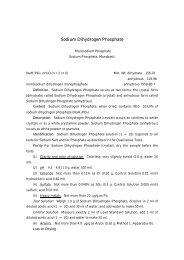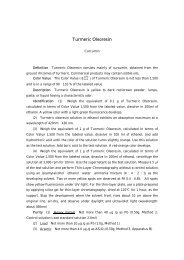You also want an ePaper? Increase the reach of your titles
YUMPU automatically turns print PDFs into web optimized ePapers that Google loves.
<strong>Propylene</strong> <strong>Glycol</strong> <strong>Alginate</strong>Description <strong>Propylene</strong> <strong>Glycol</strong> <strong>Alginate</strong> occurs as a white to yellowish whitecoarse or fine powder. It is almost odorless.Identification To 1 g of <strong>Propylene</strong> <strong>Glycol</strong> <strong>Alginate</strong>, add 100 ml of water to producea pasty solution. Use this solution as the test solution.(1) To 5 ml of the test solution, add 5 ml of lead acetate TS. It immediatelysolidifies into a gelatinous state.(2) To 10 ml of the test solution, add 1 ml of sodium hydroxide solution (1 25),heat in a water bath for 56 minutes, cool, and add 1 ml of diluted sulfuric acid (1 20). It immediately solidifies to a gelatinous state.(3) To 1 ml of the test solution, add 4 ml of water, and shake vigorously.Effervescence persists.Purity (1) Esterification value Not less than 75.0%.Calculate the esterification value of <strong>Propylene</strong> <strong>Glycol</strong> <strong>Alginate</strong> by the formulaEsterification value = 100(a + b + c) (%),where a = content (%) of free alginic acid,b = content (%) of sodium alginate,c = content (%) of insoluble ash.Obtain a, b, and c under (i), (ii), and (2), respectively.(i) Free alginic acid Weigh accurately about 0.5 g of <strong>Propylene</strong> <strong>Glycol</strong> <strong>Alginate</strong>,previously dried, dissolve in 200 ml of freshly boiled and cooled water, add 2 drops ofphenolphthalein TS, and titrate with 0.02 mol/l sodium hydroxide until the pink colorpersists for about 20 seconds. Calculate the content by the formula below. Perform ablank test in the same manner, and make any necessary correction.Content of free alginic acidVolume(ml) of 0.02 N× 0.00352sodium hydroxide consumed=× 100(%)Weight(g) of the sample(ii) Sodium alginate Weigh accurately about 1 g of <strong>Propylene</strong> <strong>Glycol</strong> <strong>Alginate</strong>,previously dried, transfer into a porcelain or platinum crucible (diameter: 2030 mm),
heat very gently at first, then gradually raise the temperature, and heat at 300400for about 2 hours until completely carbonized. After cooling, crush the carbonizedsubstance with a glass rod, transfer together with the crucible into a beaker, add about50 ml of water, and then add 20 ml of 0.05mol/l sulfuric acid. Cover the beaker with awatch glass, heat on a water bath for 1 hour, and filter. If the filtrate is colored, take anew sample, carbonize thoroughly, and repeat the procedure in the same manner.Wash thoroughly with hot water the beaker, the crucible, and the residue on the filterpaper until the washings do not turn the litmus paper red, then combine the filtrateand the washings. Titrate the excess sulfuric acid with 0.1 mol/l sodium hydroxide(indicator: 3 drops of methyl red TS) and calculate the content by the formulaContent of sodium alginate=Volume (ml) of0.05 mol / l sulfuric acid consumedWeight (g) of the sample× 0.0198× 100 (%).(2) Insoluble ash Not more than 1.5%.Dry the residue on the filter paper obtained under (1) (ii), ignite to constant weight,cool, and weigh accurately.(3) Heavy metals Not more than 20µg/g as Pb (1.0 g, Method 2, Controlsolution Lead Standard Solution 2.0 ml).(4) Arsenic Not more than 4.0µg/g as As2O3 (0.50 g, Method 3, Apparatus B).Loss on Drying Not more than 20.0% (105, 4 hours).
















